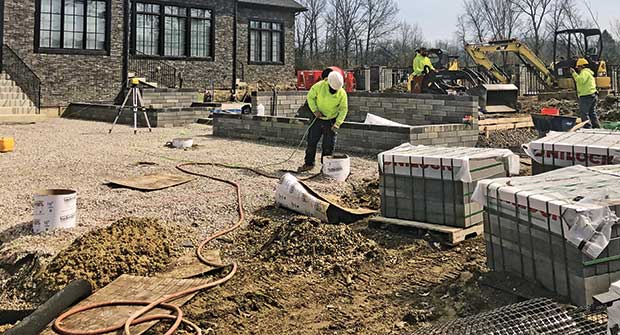6. Use the right equipment
“Equipment is a game-changer in hardscapes,” Tucker says. “Just to save on the amount of labor it would take to move material from the front of the site to the back and getting areas prepped to do the installation, you can do it 10 times faster with equipment.”
Tucker says a favorite of the Sugar Hill crew is the fleet of three Takeuchi TL8 compact track loaders.
Prime Lawn upgraded a lot of equipment in the past two years, and Griffin says those upgrades have paid big dividends on job sites. He points to a John Deere 204L loader that has helped move materials.
“The efficiency of being able to load instead of doing a (cubic) yard at a time, we can do 3 (cubic) yards at a time,” he says. “That’s five minutes less of loading materials in the trailer at a time. It all adds up quick.”
Prime Lawn also upgraded to 16-foot Big Tex dump trailers and purchased a Toro Dingo compact loader. Another big purchase was the addition of two more Weber MT vibratory rollers for porcelain paver installations.
“We had one before, and we were trying to schedule around that,” he says. “Buying two more allowed us the flexibility of not having to worry about what crew had it when.”
NeSmith says his iQ Power Tools dustless saws are a selling point for clients, especially when working in pool enclosures.
“We’ve invested in the right technology and the right equipment,” he says. “We’re not going to dust up your pool enclosure, and we’re going to clean everything up after ourselves.”
Deemer and Murray see equipment as another motivator to attract good workers.
Local Roots uses what they call an army of mini machines to work in the tight access areas within Pittsburgh city limits. These include Ditch Witch mini skid-steers and a Kubota microexcavator that shrinks down to 28 inches wide. Other favorites are a Canycom compact carrier that rotates and an Engcon tiltrotator that attaches to their excavator.
“All those have been incredible for us in terms of labor savings,” Deemer says. “It leads to a way happier workforce. If you look at the work someone is able to do, we’re two to three times the effectiveness of the employees, just because they’re running the machines.”
Additionally, Local Roots noticed that software also has been a big driver of their growth.
“Our use of LMN has truly been a game-changer,” he says. “We attribute a lot of our success to that program.”
7. Know your numbers
Bourque says another big driver of hardscape business growth is having a handle on the financial performance of your business.
“You can love being in the industry, you can love your work, but if you want to be profitable in business long term, it needs to make sense on paper,” he says.
Bourque advises companies to know which jobs are profitable and understand why and know key performance indicators such as revenue per man-hour.
“Most companies who fail do so because they don’t know their numbers,” he says. “The average net profit margin in the landscape and hardscape industry is only 3 percent net profit, and it’s only 3 percent because if they were more aware of their numbers, they could correct them quicker. What ends up happening is hardscape contractors are really good at doing the work, but they don’t spend enough time tracking their numbers.”
Bourque encourages hardscape business owners to take a look at the numbers after each job and understand the cost of material, overhead and time spent on the job versus those estimated.
“I see a common mistake of companies thinking that the gross profit margin is the actual company profit,” he says. “However, gross profit doesn’t account for the company overhead that is usually on average 20 to 30 percent. Only the net profit really counts. When business owners don’t realize this, they might end up having very little or no net profit left at the end, although it might still look like there’s money left over in the end.”
Keeping a close, constant eye on your finances will help refine your business practices to help you grow the net profit of your business.
“Making changes only once a year because you find out you’re not profitable is just not enough to run a business,” he says.
Advice
“You’ve got to put your feet on the ground, put your head down and focus on what you want to accomplish and who you are. There’s nothing quick and easy about the hardscaping industry. You’ve got to be in it for the long haul, and you’ve got to have that passion.” —Jerry NeSmith
“Surround yourself with peers in the industry, and surround yourself with people who can act as mentors. Don’t surround yourself with people in the industry who have different stated goals as you. I’m sure I could learn something from that, but that’s not what I’m going for, and that’s not what I want to do.” —Kenneth Deemer
“Don’t just let your business happen to you. You need to happen to it, and you need to make sure you’re doing what is necessary for it to continue.” —Patrick Murray
“Look at the bidding process and make sure you’re doing upfront accounting. That’s 100 percent of where you make or break your profit. It’s not the end of the job, it’s the beginning, even before you break ground. It’s how you bid for that job. My bids are actually itemized. It tells the client how many pallets they’re getting, how many tons of base material, what type of drainage we’re using, even down to the point of how many 4-inch PVC fittings we might be using on a job.” —Matt Griffin


